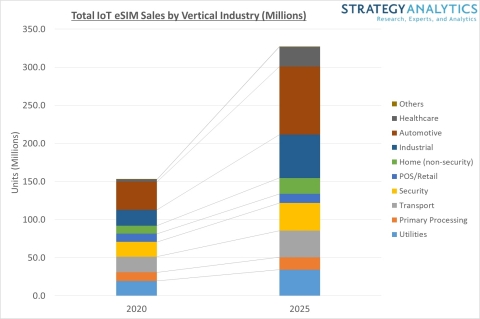Rapid IoT adoption and clear standardization will see eSIM sales ramp quickly
Strategy Analytics forecasts that sales of eSIMs for IoT applications will grow to 326 million by 2025, according to a new Strategy Analytics IoT Strategies report “How will eSIM Impact the Future of IoT and what are the Implications for Stakeholders?” eSIM (Embedded Subscriber Identity Module) has been heralded as the next evolution of the SIM card, because it offers the ability to change service provider profiles using Remote SIM Provisioning (RSP), without needing to physically change the SIM card itself, which is vital in enabling devices where it is either difficult or inefficient to access a physical SIM, for example hermetically sealed medical devices, vehicles, consumer electronic devices or a whole range of other IoT devices.

eSIM developments are now ramping-up. After years of non-interoperable eUICCs (Embedded Universal Integrated Circuit Card), the industry is now aligned with clear standards and a broad ecosystem of partners, with over 200 carriers supporting eSIM. The topic has gained further attention due to the consumer market, where eSIM adoption is being driven by smartphones, as OEMs offer an ever-growing portfolio of devices, although eSIM is also a familiar feature of tablets and laptops, eReaders, smartwatches and other wearables.
According to Andrew Brown, Executive Director of Enterprise and IoT at Strategy Analytics and author of the report:
“The growing number of SIM-enabled devices in IoT projects presents a maintenance and management headache from an enterprise perspective; the need to change SIM cards in millions of IoT devices, is impractical and unrealistic. eSIM offers a robust, scalable solution to the SIM card challenge especially for enterprises and is based on the open, vendor-neutral standard developed by the GSMA”.
“Over the last few years we have also seen growth in integrated SIM (iSIM), which builds on eSIM functionality. While an eSIM is a dedicated chip soldered on to a board and attached to a device’s processor, iSIM integrates the processor core and encryption in a system-on-chip (SoC). This is important for use cases which look for low cost, low power, and high levels of security in very small form factors. The growth in eSIM and iSIM is vital to driving seamless connectivity into as many devices as possible over the coming years,” he added.
The comprehensive report on eSIM is available here: How will eSIM Impact the Future of IoT and what are the Implications for Stakeholders?”
eSIM Forecasts are here: IoT eSIM Sales by Vertical Industry & Region and IoT eSIM Installed Base by Vertical Industry & Region
Cyberpunk Shooter Foreclosed Confirmed for PlayStation 5 and Xbox Series X














